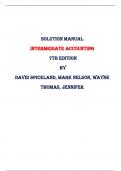Exam (elaborations)
Solution Manual For Intermediate Accounting, 7th Edition Test Bank By David Spiceland, Mark Nelson, Wayne Thomas, Jennifer | All Chapters, Latest-2023/2024|
- Course
- Institution
- Book
Solution Manual For Intermediate Accounting, 7th Edition Test Bank By David Spiceland, Mark Nelson, Wayne Thomas, Jennifer | All Chapters, Latest-2023/2024|
[Show more]




